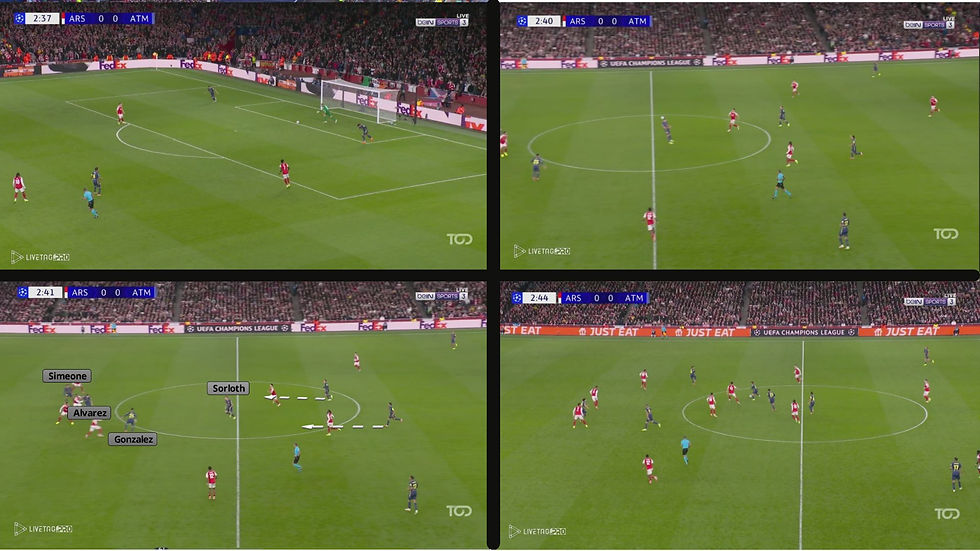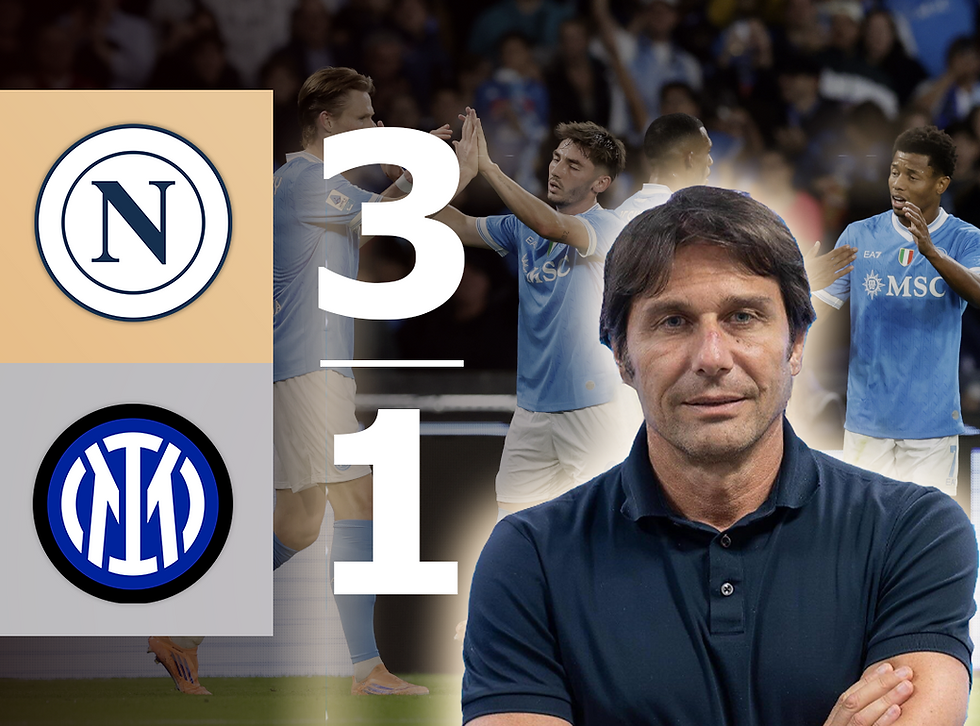ARSENAL 4–0 ATLETICO MADRID: SIGNS OF AN UNSTOPPABLE TEAM?
- Mohamed Fathalli

- Oct 22
- 6 min read

A Champions League Tuesday night at the Emirates saw Diego Simeone’s Atletico Madrid on the opposite side of the dugout, welcomed by Mikel Arteta’s Arsenal. A clash that many expected to be purely defensive from both sides. Yet the Gunners came out guns blazing, demolishing Los Colchoneros with four goals to none to collect their ninth point of the Champions League campaign.
However, while 15 goals were scored during the first halves of the other six 8 p.m. kickoffs, the Gunners were battling their way through a solid Atleti block. So, was this a game of two tales or one that revealed just how far Arsenal’s tactical evolution has come under Arteta?

Simeone Playing Into Arteta’s Hands
In the first half, Arsenal had 55% possession, nine shots - six of which came from inside the box - and an accumulated xG of 0.65. One might think the Gunners were deserving of at least one goal during that period. In fact, they did find the net through Gabriel Martinelli, albeit he was caught offside. However, despite the goal not standing, it offers a clear picture of how Arsenal created their best chances in the opening half. But in order to understand that, we need to look at how Simeone approached the game.
Atletico’s main idea in possession was to attract Arsenal’s first two lines of pressure high up the pitch, pin the defensive line, and target Sørloth to win first contact and then contest the second balls. They achieved this by having their center-backs split, their full-backs push high and wide for switches, and their pivot players, Koke and Barrios, drop deep when circulating the ball. This movement drew Gyökeres, Eze, Saka, Martinelli, and Rice forward, with Timber supporting Saka on the right-hand side while Zubimendi dropped into the back line.
Higher up the pitch, González and Simeone alternated between making runs in behind and pinning Arsenal’s defense, with Sørloth acting as the reference point and Julián Álvarez dropping between the lines to collect or fight for second balls.

This approach was also evident directly from goal kicks, with Sørloth dropping to the midfield line to be targeted by the long ball, Alvarez, Simeone and Gonzalez attacking the backline, while Koke and Barrios pushed up to join the areas where the second balls were contested.

However, for this approach to work, especially during open play, an element of risk was needed to manipulate Arsenal’s block. This risk came through the switches Atletico attempted. In some instances, particularly when the out ball was played into a safe area, these switches were completed successfully; however, they didn’t help Atletico gain significant territory, with Saka and Martinelli actively closing down space. In other moments, these very switches became Arsenal’s main source of threat.

The Gunners finished the game with nine high turnovers, four of which led to shots. One of these was Eze’s deflected effort that struck the crossbar, with Rice failing to bury the rebound. This attempt came after Atletico tried to bait Arsenal’s press, pendulum their block from one side to the other, and play the switch. Thanks to Martinelli’s positioning and reading of the situation, he intercepted the pass and allowed the Gunners to transition into attack.


Even Martinelli’s offside goal came after Atletico’s attempt to circulate possession, which Zubimendi successfully stopped with a brilliant tackle that started the transition leading to the goal.

A mixture of poor technical execution and Arsenal’s physical supremacy, yes, even against a side like Atletico, gave the Gunners the edge. Not only did Arsenal threaten their opponents by turning these high turnovers into attacks, but Simeone’s second-ball approach also played right into Arteta’s hands. Arsenal ended the first half having won 50% of their aerial duels and 55% of their ground duels with the midfield duo of Rice and Zubimendi dominating the battle for most of the first half.
The Comfort Zone Trap?
For all the dominance Arsenal displayed with and without the ball, there was still one thing missing for them to truly tear Atletico apart in that first half.
Looking at the Gunners’ first-half passing map, it’s clear how reliant they were on the right side of their attack. This came down to two factors, the first being Atletico’s approach out of possession.

The Spaniards defended in a 4-4-2 mid-block that shifted into a variation of a back five when dropping deep. This mainly occurred during Arsenal’s rotations. Koke was often tasked with marking Eze, while Barrios dropped into the back line to follow Rice, who pushed forward when Lewis-Skelly inverted into midfield. In other instances, it was Llorente who tucked inside to track Rice, with Simeone dropping into the back line to mark Martinelli.
The idea remained consistent: block the center, limit access to Skelly and Eze, and force play wide. Arsenal, on the other hand, were content to go along with Atletico’s flow.

Most of the Gunners’ final-third entries in the first half came from the wide areas, most notably through Saka. And that’s nothing new. Arsenal have long shown a tendency to attack through the wide corridors, and they did so again here, frequently creating 2v2 situations for Timber and Saka against González and Hancko on that right-hand side.

In fact, one could argue that Arsenal largely ignored the central areas altogether. In one instance, Lewis-Skelly was completely unmarked behind Atleti’s first line of defense after Koke was dragged out of position by Eze. Still, the Gunners opted to circulate the ball around the opposition’s block to create those wide 2v2 situations for Saka and Timber to exploit, and exploit them they did! Whether through the English winger taking on Hancko directly or through Timber’s supporting runs and intelligent movement into gaps, Arsenal’s right hand side was the main source of threat during that first period.

However, some might argue that this “over-reliance” on wide play could be the reason the Gunners are struggling to score goals from open play. Eze, who thrives in central areas and in combination play, could have been found on multiple occasions in the first half. Instead, he received only three passes around the D area, which, in some instances, may have limited Arsenal’s attacking threat.

Outside the Comfort Zone:
Still, it’s worth noting that Arsenal are not neglecting central penetration as much as they did last season, at least in the second half of this game. In fact, just minutes before their best goalscorer (set pieces) came on, Arteta made an adjustment that increased the Gunners’ threat.
(Picture below shows Arsenal’s Cluster of passes into final 3rd for the last season)

Instead of attacking with the usual front five, which typically includes Rice pushing into the front line, it was Zubimendi who ventured into the final third as Martinelli retained possession in a wide area. From there, Rice dropped deeper, and while Gabriel’s pass was already in motion, Llorente, who had been marking Rice earlier, was too slow to clock Zubimendi’s positioning, allowing the Gunner to slip Gyökeres through.

While some might argue that the free kick Gabriel headed home in the 57th minute opened the deadlock and allowed Arsenal to reach their full-flowing state, the earlier moments of the second half suggest otherwise. The Gunners had already begun to vary their attacking patterns, moving away from their previous overreliance on wide play. For reference, although it may not seem significant, Arsenal made five final-third entries through central areas, two more than in the first half. While that wasn’t a drastic shift, their second goal of the game came from Lewis-Skelly being found during the second build-up phase, carrying the ball into the final third, and playing Martinelli through.

The third goal also stemmed from Arsenal’s intent to penetrate Atletico’s block rather than play around it. Instead of moving the ball wide or recycling it safely, Arsenal, orchestrated by Zubimendi, looked to play through the lines and behind Atletico’s front two. This drew pressure from Simeone onto Lewis-Skelly, thereby creating a 1v1 situation higher up the pitch for Martinelli against Llorente. Thanks to Lewis-Skelly’s composure and Zubimendi’s awareness, the ball was worked out of pressure and into the Brazilian, who paved the way for Arsenal’s third goal of the game.

And of course, Mr. Freekick returned once more for the Gunners, as Gyökeres netted his second goal of the game by slotting the ball home after Gabriel’s effort from yet another corner.
Arsenal’s second-half display was a sign of Arteta’s intent to attack through the center, which is a noticeable shift from last season. That added variation made all the difference, giving the Gunners more ways to manipulate Atletico’s block, break lines, and create quality chances rather than trying to keep it safe and playing around the block all the time. The balance between width and central penetration brought a new edge to their game, something that they lacked before. And when you combine that with a side yet to concede in the Champions League and having let in just three Premier League goals, you sense this Arsenal team might have something to say this campaign.
Are You a Football Coach or Analyst?
Discover the X-Planner by The Coaches Zone - the ultimate all-in-one book designed to help coaches, analysts, scouts, and managers stay organised, prepared, and ahead of the game.
Plan sessions, track match details, analyse performance, and document ideas - all in one professional, durable planner made for the modern football mind.

.png)



Comments